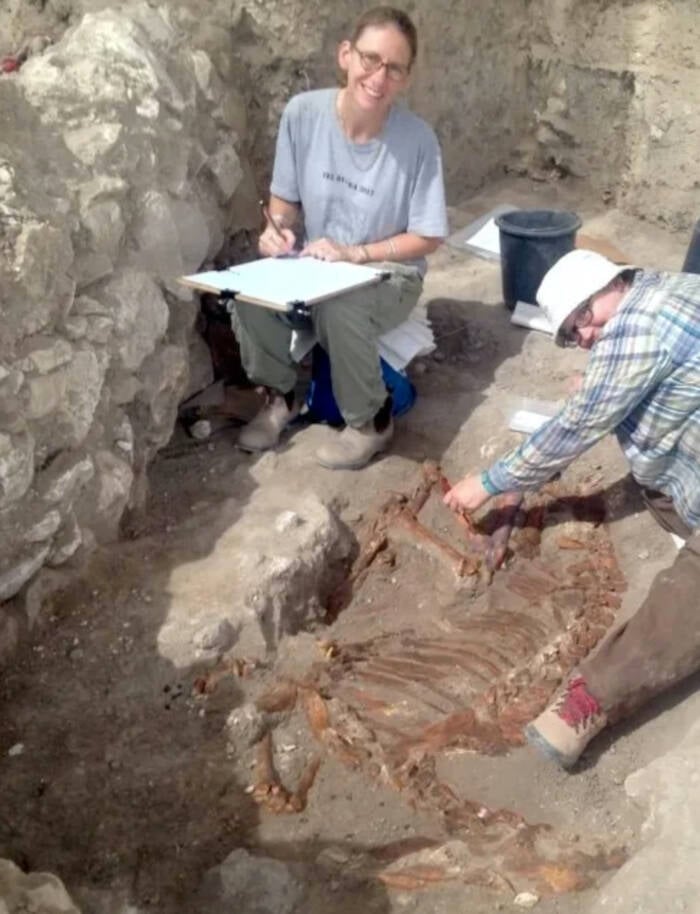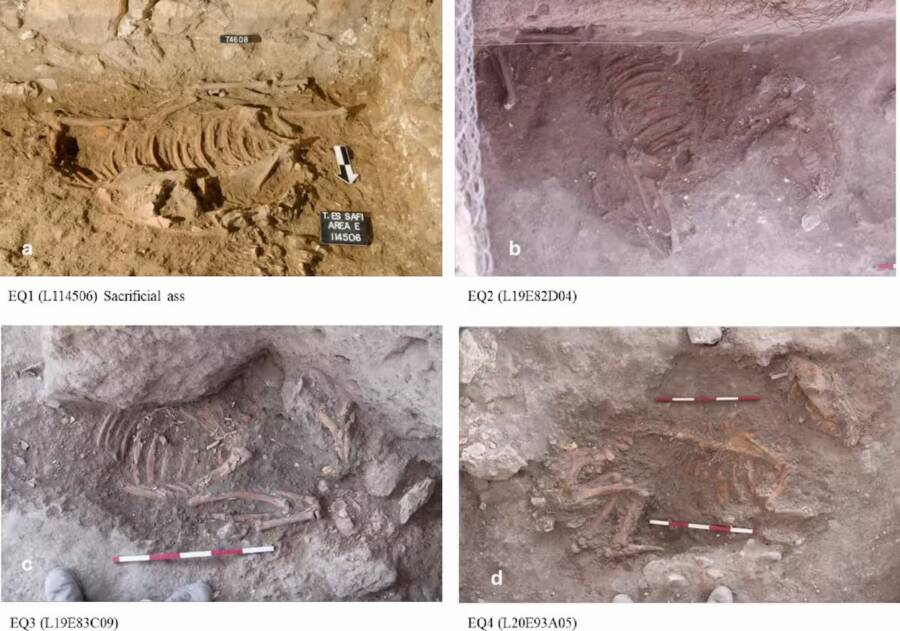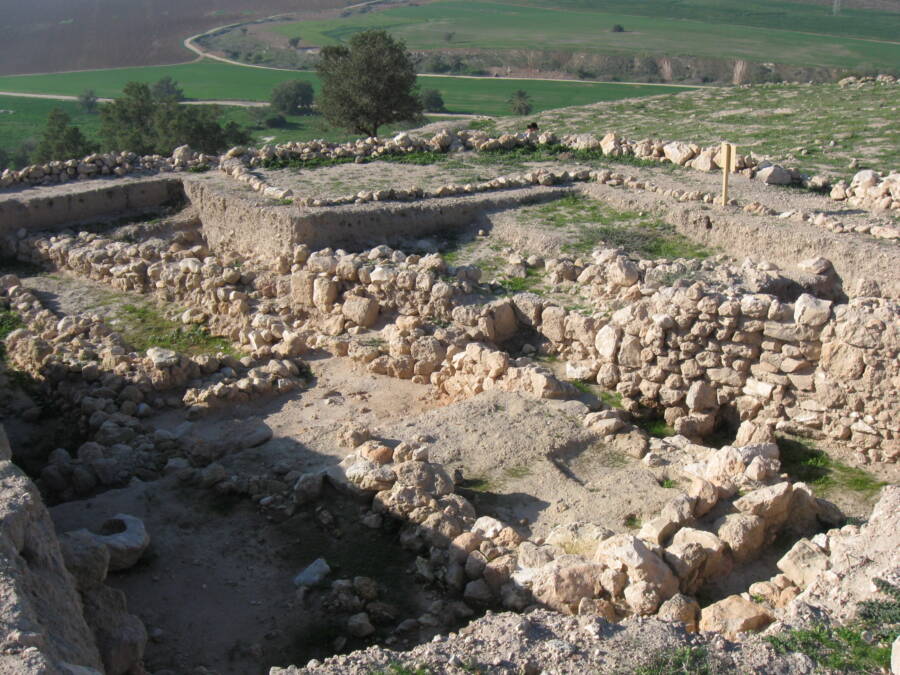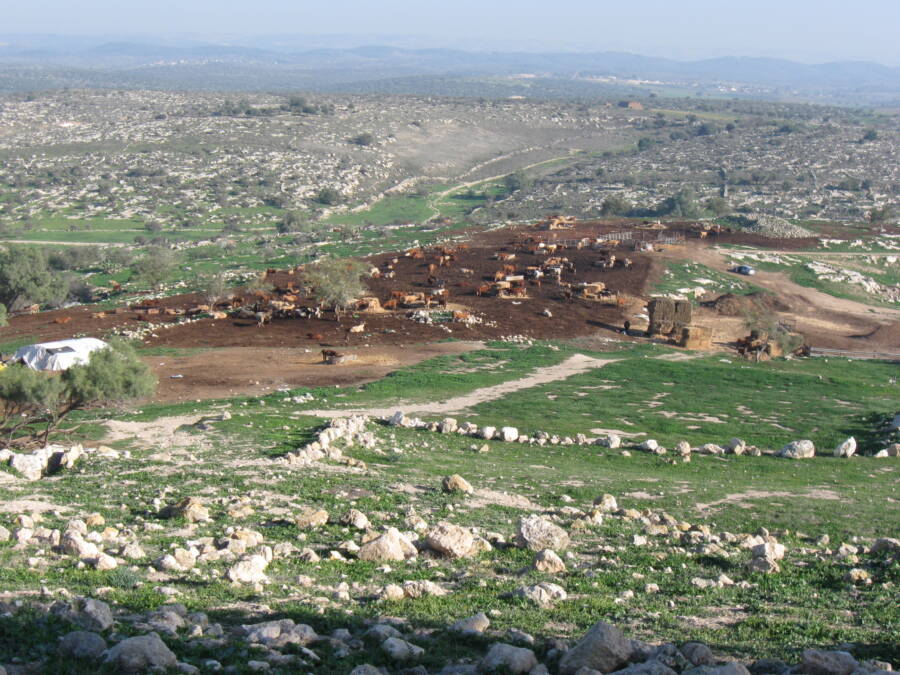Found in the ancient Canaanite city of Gath, located in Tell es-Sâfi, Israel, three of the donkeys were found with their legs bound and the fourth was decapitated with its head placed on its abdomen.

Arnold et al., 2025, PLOS OneThough researchers believe they may have been killed to gain prosperity or divine protection, the full story behind this grisly find remains shrouded in mystery.
Archaeologists working in the ancient Canaanite city of Gath in Tell es-Sâfi, Israel recently made a curious find when they discovered four female donkeys buried beneath a house. The donkeys appear to have come from Egypt and experts believe that they were ritualistically sacrificed some 4,500 years ago.
Many questions about this presumed donkey sacrifice still remain, but researchers suspect that the donkeys were killed and carefully buried to bring good fortune to the house’s owners.
The Bronze Age Donkey Sacrifice Uncovered At The Ruins Of Gath
According to a recent study published in PLOS One, the complete remains of four female donkeys were found beneath a 4,500-year-old house in Gath, an ancient Canaanite city located in present-day Tell es-Sâfi, Israel.

E.R. Arnold et al.The donkeys were all buried in a similar manner beneath the house.
The four donkeys, young and healthy at the time of their death, were buried in shallow pits beneath the ancient home with their heads facing toward the east. Three were found with their legs bound, and one had been decapitated, with its head placed on its abdomen. Upon closer inspection of their remains, researchers also found that the four female donkeys were distinctly different from other donkeys in the area.
By studying the donkeys’ teeth, researchers found that the animals had originally come from the Nile Valley in Egypt. A chemical analysis indicated that they had been raised consuming water and grasses found near the Nile, and their strontium levels matched Egyptian soil. By contrast, the remains of local donkeys suggested that they had grazed on Israeli plants and grasses.
Researchers also found that local donkeys had been discarded as waste, whereas the four Egyptian donkeys were buried with obvious care beneath the house. Thus, it seems highly likely that donkeys beneath the house were purposefully imported from Egypt, and then ritually sacrificed in Israel.
“The intentionally buried of specifically imported and highly valued young jennies,” the researchers reported, “reveal what appears to be a ritually charged characteristic when constructing domestic residences at the site.”
But why?
Why These Egyptian Donkeys May Have Been Sacrificed 4,500 Years Ago

Ori~/Wikimedia CommonsThe ancient ruins of Gath at Tell es-Sâfi, which was once one of the largest cities in the southern Levant.
Some 4,500 years ago, Gath was one of the largest cities in the southern Levant, and an important center of trade. Egypt was one of the city’s trading partners, and researchers suspect that the donkeys were chosen as sacrificial animals because of what Egypt represented at the time.
Egypt was then a powerful civilization in the region, and the donkeys may have thus represented strength and prosperity. The donkeys, imported from Egypt, represented Egyptian power, and were possibly sacrificed in hopes of bringing prosperity or divine protection to the house’s owners.
“It was not any donkey that was deemed worthy of sacrifice at Tell eṣ-Ṣâfi/Gath, but only Egyptian young females,” the study’s authors explain. “This suggests the function of these sacrifices is not simply a totem animal or an occupation marker but was socially and ritually charged by having come from Egypt. The importance and charged significance of the display of economic, and likely social and political connections with Egypt, was an integral part of the sacrificial ritual. Thus, an Egyptian donkey might have been seen as an exotic and special animal, worthy of specific ritual use.”

Ori~/Wikimedia CommonsThe ruins of Gath, an ancient Canaanite city located in present-day Israel.
Still, questions about the donkeys sacrificed in Gath remain. Who arranged the sacrifice of the donkeys? Who did the home belong to? What did the homeowners hope that the sacrifice would bring them? And why were donkeys — and not another animal — chosen for this important ritual?
While the answers may be difficult to ascertain, the discovery of the sacrificed donkeys offers a fascinating look back at life in this region during the Early Bronze Age, at a time when Egypt reigned so supreme that even its donkeys were thought to possess special power.
After reading about the ancient donkeys that were seemingly sacrificed, discover the story of Moloch, the ancient pagan god of child sacrifice. Then, learn about the mysterious Sea Peoples, the unknown civilization that terrorized the ancient world.





